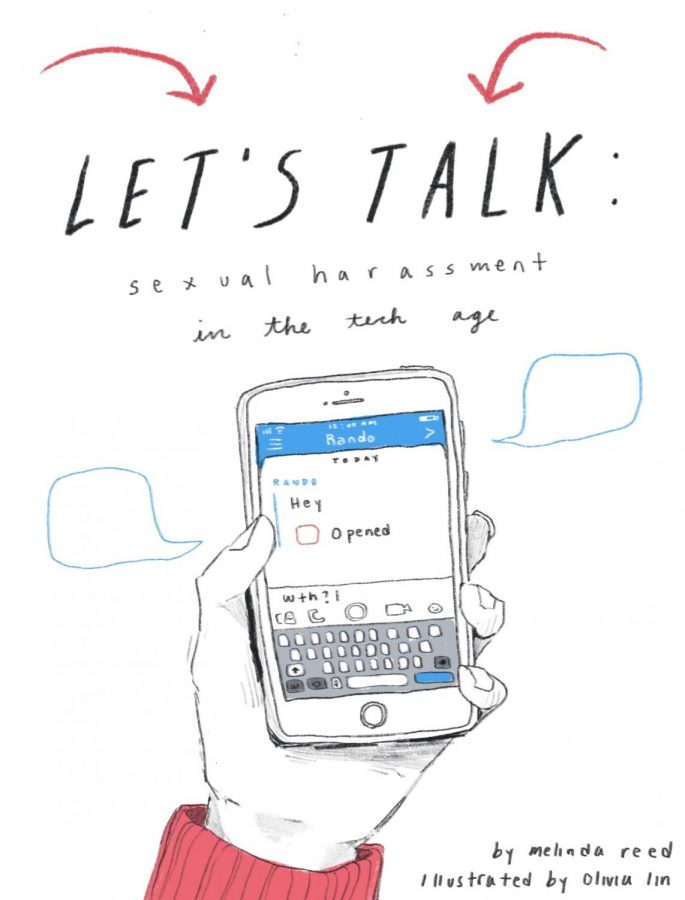Same Beast, Different Form: Sexual Harassment in the Technological Age
Please note that this article discusses sensitive topics such as suicide, self-harm, and sexual harassment.
All names have been changed to protect the anonymity of interviewees.
For centuries, silence has been treated as the cure-all for victims of sexual misconduct. To be clear, silence never cured anything, instead offering the convenience of plausible deniability. If we do not talk about sexual harassment, sexual assault, and rape, then maybe it will go away.
That started to change in recent years, especially with the introduction of the #MeToo movement and social exile of America’s most powerful predators. Celebrities, government workers, and everyday people spoke out about the trauma they experienced. Attackers and harassers were punished accordingly.
Almost instantaneously, silence was no longer the answer. Instead, people- especially women- had the space to speak and be listened to. In the same way we never feel the earth spinning on its axis, we rarely ever feel social progress happening because it occurs in invisible increments. But for those few months in 2018, we felt change taking place. The culture and politics of the United States would never be the same and we knew it.
Leaders falling from grace, old stories of fear and guilt rising to attention. In all this chaos, we forgot to ask the most important question: how did our society allow this to happen?
. . . . . .
Emily was in English class when she opened a video on Snapchat and the boy on her screen started pulling down his pants.
“My friend took my phone and responded,” she recalls. “And I have no idea what they said, but then they opened the next Snapchat and threw my phone across the room.”
At first, Emily struggles to find the words to describe what was on her screen. There’s a colloquial term for this kind of photo, but she hesitates to use it in the formal setting of an interview. “It was a picture of male genitalia,” she finally says, laughing nervously.
Unfortunately, for teenagers today, Emily’s story is nothing extraordinary. When asked how common it was for students to receive an unsolicited picture of genitalia, all six people interviewed cited it as a typical occurrence. A 2017 survey from the Pew Research Center found that of women aged 18 to 34, 52% reported receiving an “explicit image they didn’t ask for,” as did 36% of men in the same age range.
Dr. Cory Pedersen, a professor and psychologist at the Kwantlen Polytechnic University in British Columbia, has studied this exact topic. “In my own investigation, almost 50% of our over 1000 participants admitted to having sent unsolicited images of their genitals,” she says. “Other studies asking men whether they have ever engaged in this practice have reported similar results, and studies asking women whether they’ve received such images suggest the numbers might even be higher than what men themselves report.”
For this generation, for whom the majority of socialization takes place on social media, pictures like these are the new form of flashing. In the same way a flasher can harass someone passing by on the street, people who send pictures of their genitalia experience few, if any, consequences, and maintain a certain level of anonymity. Interviewees reported that while sometimes photos were sent from people they knew well, they often came from friends of friends or strangers within the same social circle. When the recipient of an image goes to a different school, the harasser is far less likely to be confronted about the picture. The lack of consequences seems likely to make for repeated offenses.
In most of these situations, there are gender dynamics at play. While boys sending a picture of their penis is the most common, girls have also sent unsolicited pictures of their genitalia to boys.
Matt, a Morris Hills student, has received about two or three non-consensual images from girls. However, while he is still a victim whose rights were violated, his reaction was very different from Emily’s. “If guys are receiving an unsolicited [picture] we’re like oh, yeah, high five, when a girl’s like ew, I have to go tell somebody.” Despite this, he described feeling surprised at getting pictures, especially in one instance when he was in the middle of helping organize donations to a charity with his family. “I was checking my phone… and I opened up Snapchat, and I was like woah, okay, let’s put the phone away.”
Of the research done on this topic, very little is devoted to women who send explicit pictures, but Dr. Pedersen is currently looking at one of the few studies out there. “Although that study isn’t done yet, I would hypothesize that women who send such images probably have many of the same motives as men,” she says, which include “[signaling] sexual interest,” “spurring on a sexual interaction,” and sending pictures “because they hope to receive a similar image in return.”
Matt’s experience touches on one of the dangers of this new form of sexual harassment. Whereas in the past this treatment has been relegated to the streets or the workplace, today it happens at home, at school, and even when hanging out with friends or family. The only way to escape it is to stop using social media, which is not an appealing option for most teenagers. Apps like Snapchat and Instagram serve as their connection to the outside world and quitting them would mean social isolation.
And even if every teenager stopped using social media, the root problem- that some young people feel entitled to receive sexual gratification from sending explicit, non-consensual photos- would not change. Like the heads of the hydra, once one form of sexual harassment is stopped, two more appear in its place. But the monster itself never truly dies.
. . . . . .
For their prevalence, non-consensual pictures of genitalia receive relatively little attention in the media. The attention they do receive tends to focus on adults and online dating, as opposed to teenagers and Snapchat.
There are multiple reasons for the silence on this topic. First is the simple fact that teenagers often don’t tell their parents or other adult figures about such images. Doing so risks the confiscation of a phone or prohibition of social media, which is the primary mode of communication. The victim, not the harasser, can be punished for images they had no control over receiving. And outside of the potential consequences a victim can experience, there’s the discomfort of talking to an adult about a taboo topic.
The second reason for silence is perhaps more troubling. Throughout the interviews, there was a mindset shared by the victims that these pictures were no big deal- that since it happened all the time, and to so many people, it could not be that wrong. Even though they all had personal emotional responses, there was a difference between how they felt and what they “should” feel. With many people dismissing it as a fact of life, the current conversation over the issue leaves little space for emotions like hurt and anger.
For Emily, this has been especially difficult when it comes to her experiences with sexual extortion. In one instance, a boy she did not know well threatened to kill himself if she did not send nude pictures. “I’m not going to do that, is there anything else I can do?” she recalls saying. He refused any help and repeated the threat of suicide. The situation escalated as Emily tried to ascertain if he was around any objects he could potentially use to hurt himself. “The only thing he would say is ‘Send me nudes, otherwise I’m going to kill myself.’ ” she remembers. The conversation ended when he sent a picture with evidence of self-harm. This was one instance where she did tell her parents about what had transpired. They wanted to press charges, but Emily hoped to forget it had ever happened. To this day, she doesn’t know what happened to the boy she was talking to, who turned out to be from Australia. For her, this uncertainty is equally painful in its own right.
Unfortunately, it wouldn’t be the last time she would be threatened online. More recently, a boy demanded she send nude pictures of herself, otherwise he would post nude images of another girl and claim it was Emily. The altercation ended only when a male friend intervened on her behalf and she blocked the harasser.
Again, these are extreme cases on the spectrum of online sexual harassment. The danger lies in thinking that just because unsolicited pictures are not as severe a threat as sexual extortion, they are not a threat at all. Every type of online sexual harassment is wrong, every victim should be heard, and every person deserves to operate online without being subjected to aggressive explicit behavior.
. . . . . .
There is no way of knowing how many Morris Hills students are either the perpetrators or victims of this phenomenon. While a conversation with most students implies that it’s common place, Harassment, Intimidation, and Bullying Coordinator Mrs. Gentile says that guidance receives few reports of this nature.
Even so, the school is prepared to respond to such a situation. Mrs. Gentile emphasizes that a picture sent off school grounds can still be addressed by the school- namely, Morris Hills’s school resource officer, Officer MacQuesten. Because many of these unsolicited explicit pictures are taken by minors, they technically qualify as child pornography, which means the unwilling recipient is now in possession of an illegal item. Even if the recipient is also a minor, they can still be charged for this crime.
But Officer MacQuesten wants to make it clear to victims that they will not get in trouble if they bring this information to him. “It’s kind of like if someone threw drugs on the front seat of my car,” he explains. “[If] I call the police immediately and say, like, ‘Hey, someone just put drugs on the front seat of my car. It’s not mine, can you come get it?’ Well, now I’m not going to get in trouble. But if I get pulled over three months from now and I left the drugs there, well, now they’re my drugs. That’s what kind of ends up happening with these nude picture situations, people will keep it on their phone.”
In essence, this means that students who receive photos of genitalia without their consent and keep them only face risks if they do not report the incident. While this puts pressure on the victim to discuss something they may find difficult or uncomfortable, it also makes silence the less palatable choice, which can help the school take action in these situations.
As the student resource officer, Officer MacQuesten begins every investigation by collecting as much information as possible. This means interviewing everyone involved, including everyone who may have received the sexual photo and the person responsible for the picture. Once the investigation is over, Officer MacQuesten brings in the harasser, victims, and the parents to do the phone search. “That’s probably the most uncomfortable part of the whole thing,” he says. “I have to go through the phone with them to make sure they’re deleting the pictures… I don’t want to see that.”
The next step is the stationhouse adjustment. Created under New Jersey law to avoid permanently tarnishing juveniles’ records with minor offenses, the stationhouse adjustment allows law enforcement to take an educational approach to handle the situation instead of seeking punishment. The stationhouse adjustment requires the harasser to complete certain tasks, such as sensitivity training or community service, in order to keep the incident off their record. If the harasser violates the adjustment, they risk getting charged with a crime, either the possession of child pornography, cyberharassment, or both.
In his experience, Officer MacQuesten says, most of these harassers have made the assumption that sending an unsolicited picture is an acceptable way of starting a relationship. Dr. Pedersen’s research echoes this pattern.
“Men report that they send such images with ill-advised, but generally good intentions,” she says. “… they believe (incorrectly) that this is a normal way of flirting.”
Based on these reports, it seems that the majority of the harassers who walk our halls are not terrible people, but terribly misguided in assuming it is their right to pleasure themselves at the emotional expense of others.
Even if it doesn’t show itself now, this emotional expense still exists. If nothing else, these photos send a message that sex is about one person taking advantage of another’s vulnerabilities instead of an act between two willing partners. This is the very ideology that has dominated American society for decades, the thinking at the root of every act of sexual harassment or assault. Left unchecked, this phenomenon in high schools will foster a new generation of adults with a fuzzy concept of consent.
This can have very real consequences. The harassers of the #MeToo movement did not emerge fully formed. Instead, they were raised and shaped by a society that did not properly respond to sexual harassment, or simply did not respond at all.
“It is my opinion – which for the record is always based on science – that it would be much more effective to offer comprehensive sexuality education to teens about issues related to sexual harassment and consent… than it would be to try and pass laws to regulate sexual behavior,” says Dr. Pedersen. Since everything takes place online, it is difficult to legislate the issue. Even if it is possible, enforcement may not be the best solution. “Education is prevention. Laws are intervention,” Dr. Pedersen continues. “We should always strive for prevention over intervention where possible.”
. . . . . .
When asked what she would say to the boys who sent her these pictures, Emily has an immediate answer. “When you’re older, not in your twenties, not in your thirties, in your forties, your fifties… you’re going to remember sending unsolicited images to girls and you are going to think ‘What was wrong with me?’ And you’re going to have to live with the fact that you can never take that back, ever. You’re not going to be able to find all the girls you sent them to and apologize.”
Despite this, as the interview comes to a close, Emily grows more optimistic about the future of sexual harassment in our generation. “Don’t people say that when guys grow up and have girls it’s karma or something? …now they’re going to be the person that has to comfort their daughter when some guy like they were when they were younger hurts her.” She is thoughtful, hopeful. “And so maybe then, once that happens, they’ll realize.”
If you or someone you know is having suicidal thoughts, please contact the National Suicide Prevention Lifeline at 1-800-273-8255, or visit suicidepreventionlifeline.org for more resources.
If you are a victim of sexual assault, please contact the National Sexual Assault Telephone Hotline at 1-800-656-4673, or visit rainn.org for more resources.


